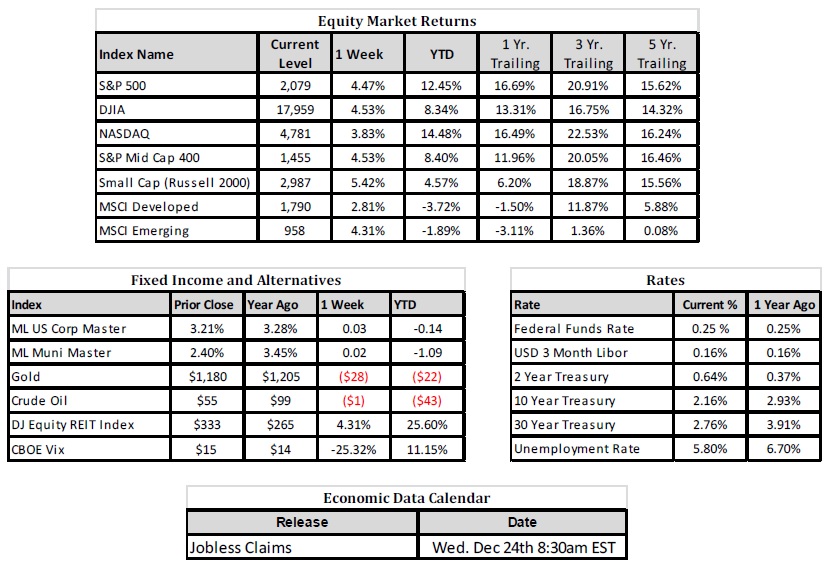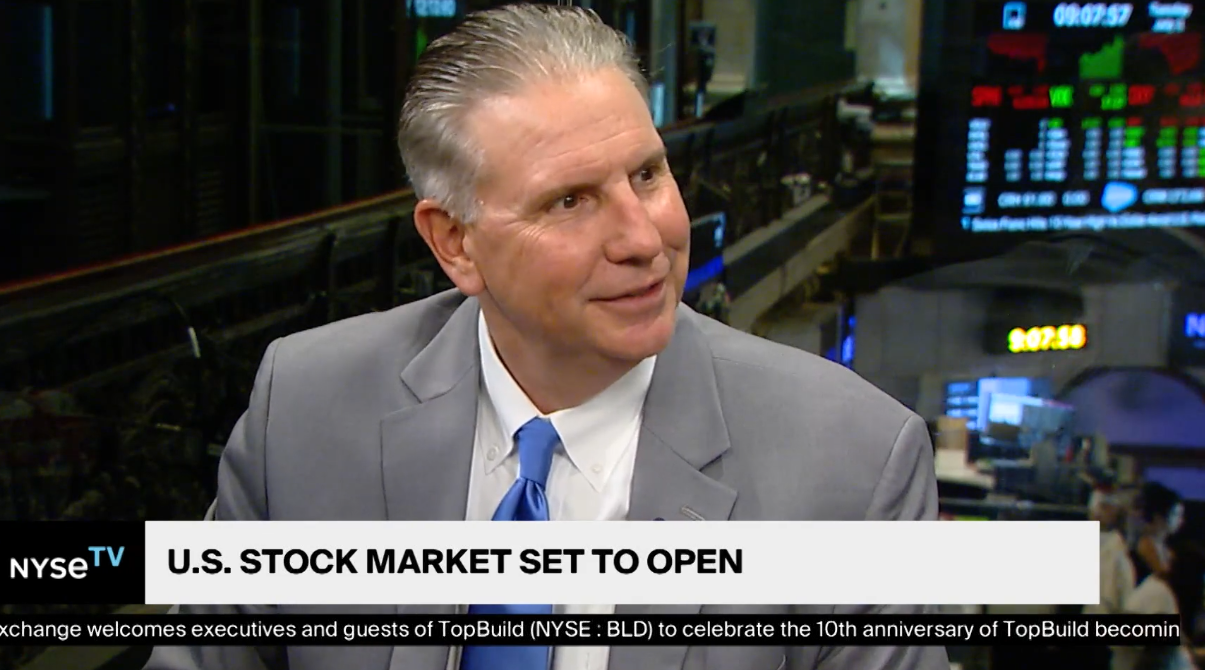
Capital Markets Update – Week of 12/22/2014
Market Overview
Sources: Rates Data and Economic Calendar—Bloomberg Markets as of 12/23/14; Equity Market Returns and Fixed Income and Alternatives Data—Wells Fargo Advisers as of 12/19/14.
Happening Now
Stocks Move Higher on Fed Statement and Oil
Last week, stocks (as measured by the S&P 500) see-sawed losing a cumulative 1.5% in Monday and Tuesday’s trading before reversing to earn a cumulative 4.9% Wednesday through Friday to finish the week up 12.8% for the year. The increase in stock returns coincided with the FOMC’s final meeting of 2014 during which they assured market participants the committee would be “patient” when considering raising interest rates and kept the “considerable time” language within the body of their statement (full text here.1) We expect the Fed to raise interest rates at some point during the first half of 2015 but what should have greater implications is the level to which the Fed will allow interest rates to rise. The chart below shows the disparity of interest rate projections within the FOMC and summarizes member’s projections for the Fed Funds Rate at the end of 2015:
| 2015 Fed Funds Rate Projections | |
| Fed Funds Rate | # of Projections |
| 0.00-0.25% | 2 |
| 0.25-0.50% | 0 |
| 0.50-0.75% | 2 |
| 0.75-1.00% | 4 |
| 1.00-1.25% | 3 |
| 1.25-1.50% | 0 |
| 1.50-1.75% | 2 |
| 1.75-2.00% | 4 |
Source- Federal Reserve http://www.federalreserve.gov/monetarypolicy/files/fomcprojtabl20141217.pdf
The market, however, continues to believe that the Fed is more hawkish than they are letting on. Futures are currently pricing the Fed Funds Rate during December 2015 to average 0.66%2. This may be a reflection of lower inflation expectations since the path of interest rates in 2015 will likely be very dependent on future PCE (Personal Consumption Expenditures) data. The central tendency of the Fed’s expectation for inflation is 1.5 – 1.8%. Should inflation trend lower than this expectation, the Fed may (and in our opinion, will likely) take a more gradual path to raising rates.
In addition to “Santa Yellen’s” gift to investors long U.S. Stocks, volatility in the oil market has begun to subside. While we expect oil to remain somewhat of an uncertainty heading into 2015, we are encouraged to see that the volatility (as measured by standard deviation) has decreased to approximately 5.5% since the start of December. To put this perspective, volatility (again measured by standard deviation) since the start of the quarter has been around 10.7%3*. While we understand that the statistical significance of the recent decrease in volatility isn’t on par with the entire quarter’s worth of data, we believe that reduced uncertainty and positive short term prospects of lower oil prices are one of the factors helping the market to climb higher.
We at SmartTrust® wish you and your family a happy and health holiday season and prosperous New Year!
- http://www.federalreserve.gov/newsevents/press/monetary/20141217a.htm
- http://www.cmegroup.com/trading/interest-rates/stir/30-day-federal-fund.html
- http://www.eia.gov/dnav/pet/pet_pri_spt_s1_d.htm
*Volatility data is as of 12/15/14
Important Information and Disclaimers
Past Performance is not a guarantee of future performance.
Investing in foreign securities presents certain risks not associated with domestic investments, such as currency fluctuation, political and economic instability, and different accounting standards. This may result in greater share price volatility. These risks are heightened in emerging markets.
There are special risks associated with an investment in real estate, including credit risk, interest rate fluctuations and the impact of varied economic conditions. Distributions from REIT investments are taxed at the owner’s tax bracket.
The prices of small company and mid cap stocks are generally more volatile than large company stocks. They often involve higher risks because smaller companies may lack the management expertise, financial resources, product diversification and competitive strengths to endure adverse economic conditions.
Investing in commodities is not suitable for all investors. Exposure to the commodities markets may subject an investment to greater share price volatility than an investment in traditional equity or debt securities. Investments in commodities may be affected by changes in overall market movements, commodity index volatility, changes in interest rates or factors affecting a particular industry or commodity.
Products that invest in commodities may employ more complex strategies which may expose investors to additional risks.
Investing in fixed income securities involves certain risks such as market risk if sold prior to maturity and credit risk especially if investing in high yield bonds, which have lower ratings and are subject to greater volatility. All fixed income investments may be worth less than original cost upon redemption or maturity. Bond Prices fluctuate inversely to changes in interest rates. Therefore, a general rise in interest rates can result in the decline of the value of your investment.
Definitions
MSCI- EAFE: The Morgan Stanley Capital International Europe, Australasia and Far East Index, a free float-adjusted market capitalization index that is designed to measure developed-market equity performance, excluding the United States and Canada.
MSCI-Emerging Markets: The Morgan Stanley Capital International Emerging Market Index, is a free float-adjusted market capitalization index that is designed to measure the performance of global emerging markets of about 25 emerging economies.
Russell 3000: The Russell 3000 measures the performance of the 3000 largest US companies based on total market capitalization and represents about 98% of the investible US Equity market.
ML BOFA US Corp Mstr [Merill Lynch US Corporate Master]: The Merrill Lynch Corporate Master Market Index is a statistical composite tracking the performance of the entire US corporate bond market over time.
ML Muni Master [Merill Lynch US Corporate Master]: The Merrill Lynch Municipal Bond Master Index is a broad measure of the municipal fixed income market.
Investors cannot directly purchase any index.
LIBOR, London Interbank Offered Rate, is the rate of interest at which banks offer to lend money to one another in the wholesale money markets in London.
The Dow Jones Industrial Average is an unweighted index of 30 “blue-chip” industrial U.S. stocks.
The S&P Midcap 400 Index is a capitalization-weighted index measuring the performance of the mid-range sector of the U.S. stock market, and represents approximately 7% of the total market value of U.S. equities. Companies in the Index fall between S&P 500 Index and the S&P SmallCap 600 Index in size: between $1-4 billion.
DJ Equity REIT Index represents all publicly traded real estate investment trusts in the Dow Jones U.S. stock universe classified as Equity REITs according to the S&P Dow Jones Indices REIT Industry Classification Hierarchy. These companies are REITSs that primarily own and operate income-producing real estate.




